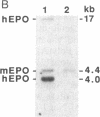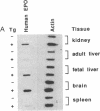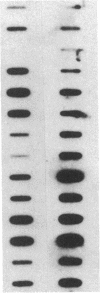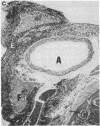Abstract
Erythropoietin is a glycoprotein hormone that regulates mammalian erythropoiesis. To study the expression of the human erythropoietin gene, EPO, 4 kilobases of DNA encompassing the gene with 0.4 kilobase of 5' flanking sequence and 0.7 kilobase of 3' flanking sequence was microinjected into fertilized mouse eggs. Transgenic mice were generated that are polycythemic, with increased erythrocytic indices in peripheral blood, increased numbers of erythroid precursors in hematopoietic tissue, and increased serum erythropoietin levels. Transgenic homozygotes show a greater degree of polycythemia than do heterozygotes as well as striking extramedullary erythropoiesis. Human erythropoietin RNA was found not only in fetal liver, adult liver, and kidney but also in all other transgenic tissues analyzed. Anemia induced increased human erythropoietin RNA levels in liver but not kidney. These transgenic mice represent a unique model of polycythemia due to increased erythropoietin levels.
Full text
PDF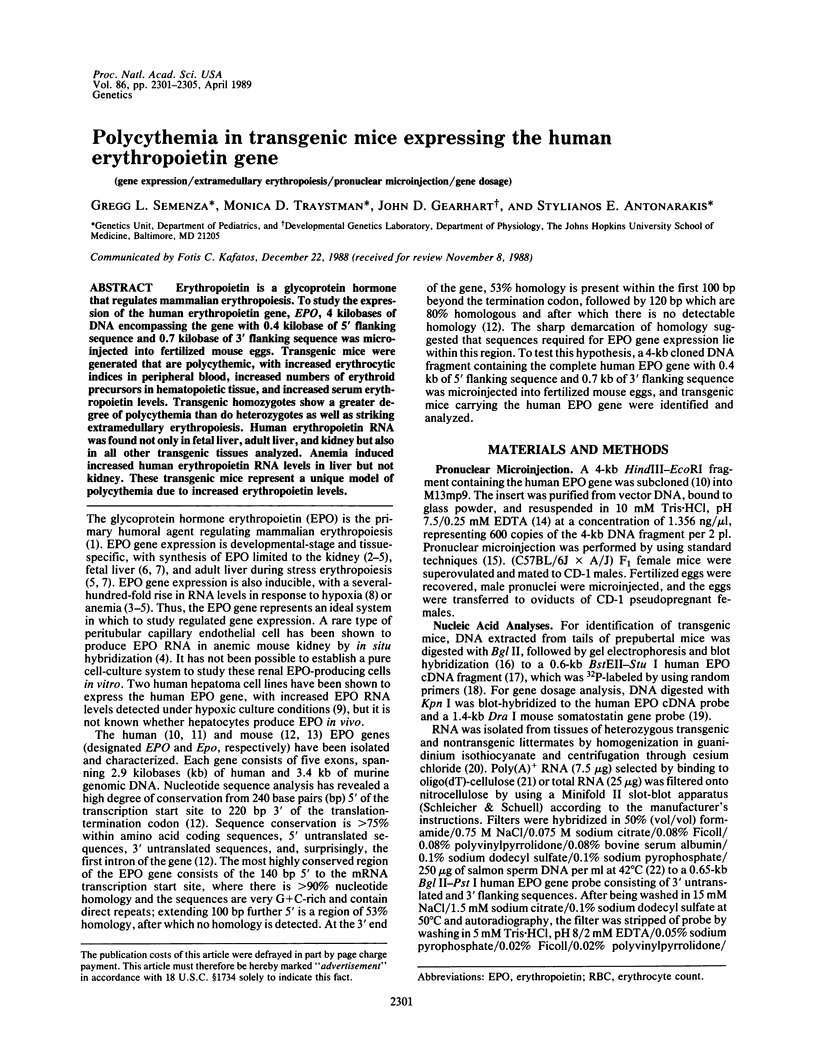
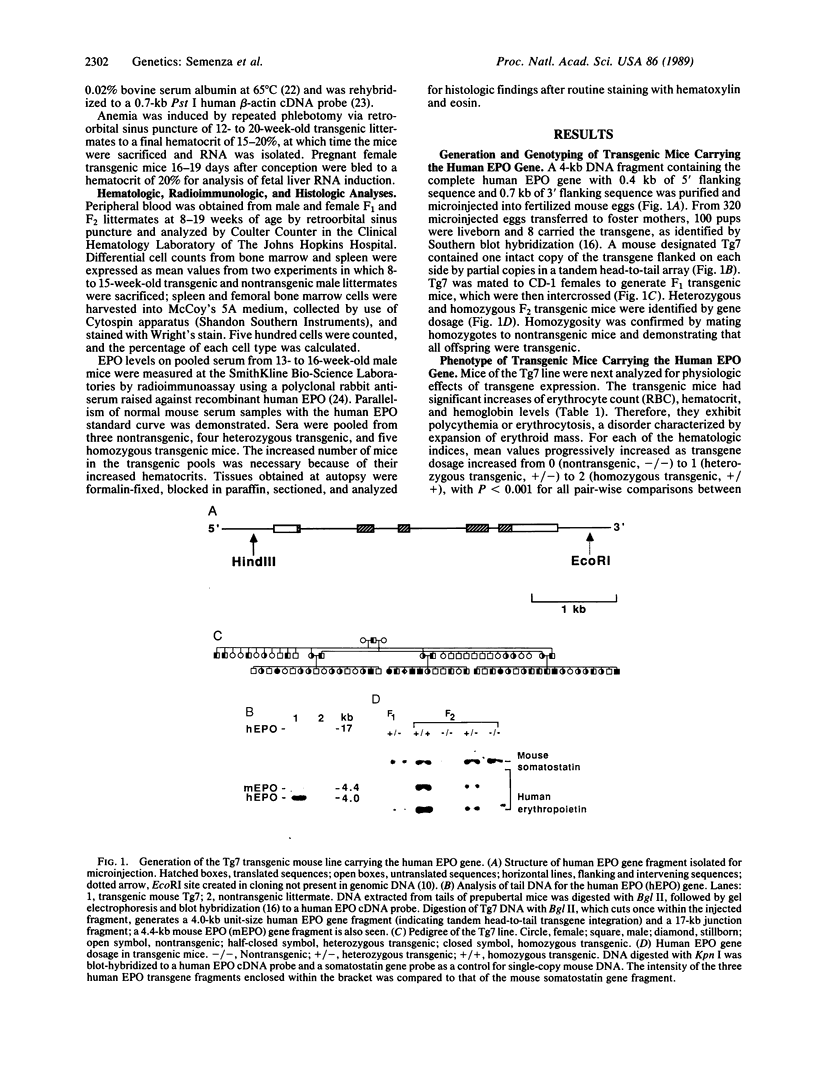
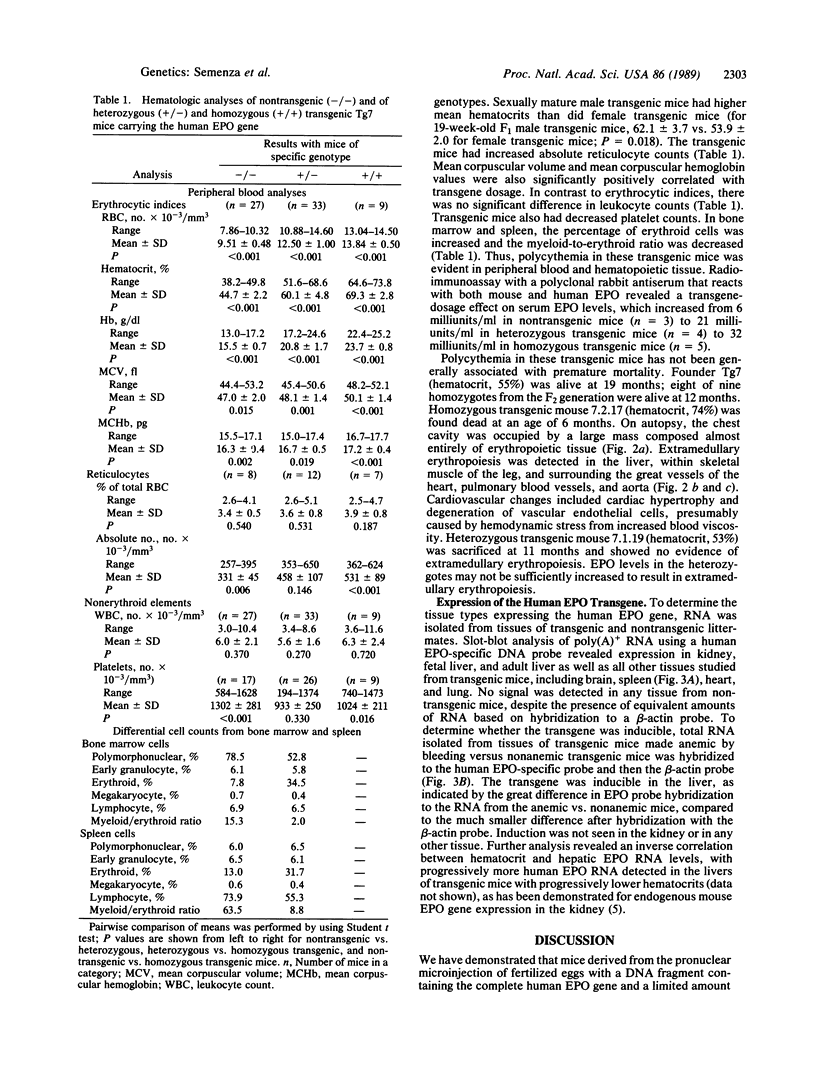
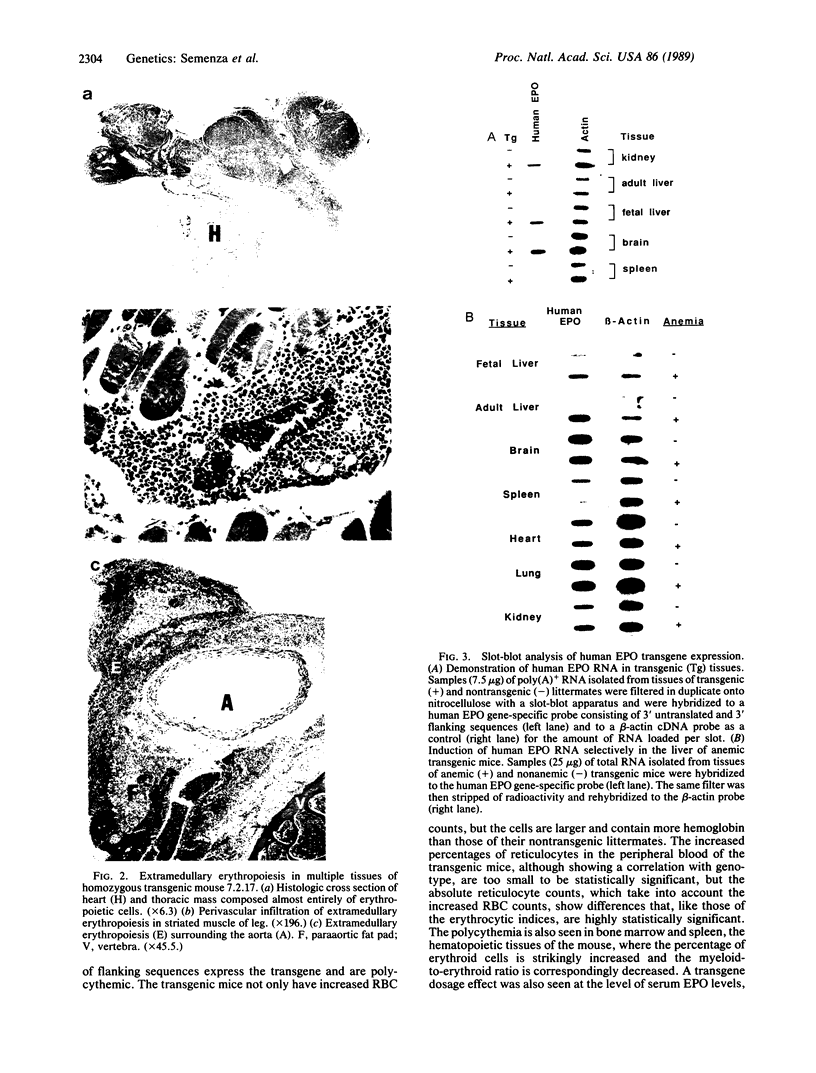
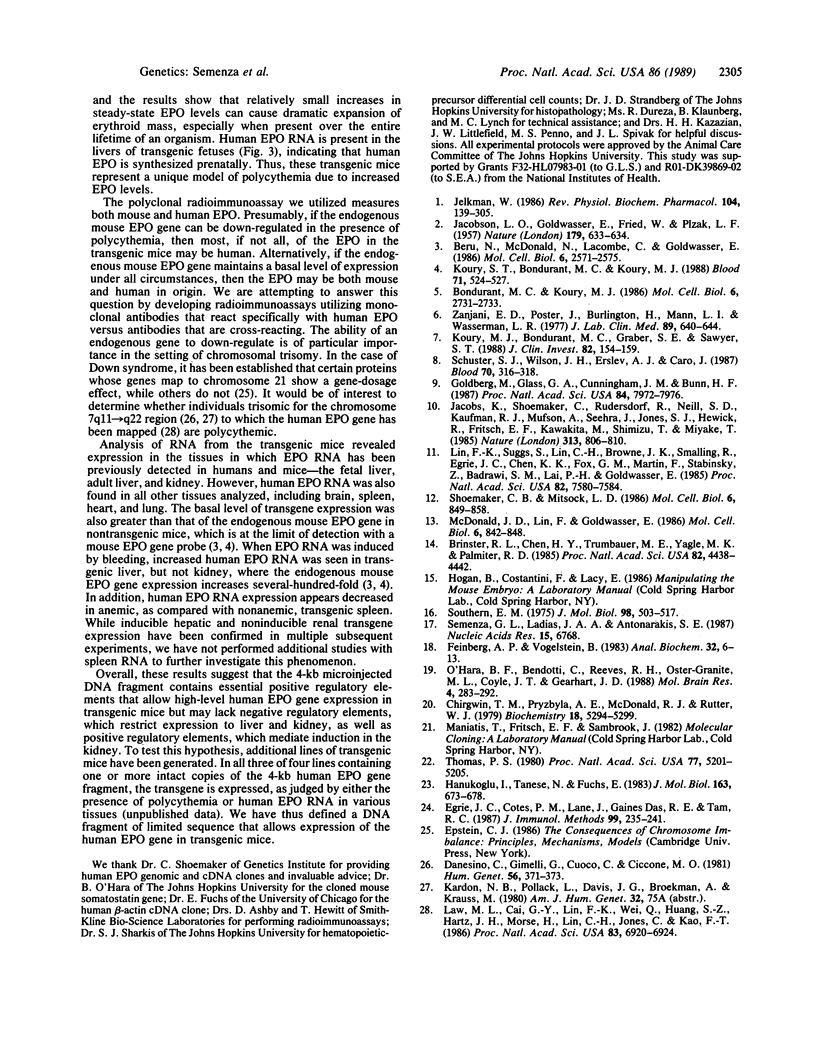
Images in this article
Selected References
These references are in PubMed. This may not be the complete list of references from this article.
- Beru N., McDonald J., Lacombe C., Goldwasser E. Expression of the erythropoietin gene. Mol Cell Biol. 1986 Jul;6(7):2571–2575. doi: 10.1128/mcb.6.7.2571. [DOI] [PMC free article] [PubMed] [Google Scholar]
- Bondurant M. C., Koury M. J. Anemia induces accumulation of erythropoietin mRNA in the kidney and liver. Mol Cell Biol. 1986 Jul;6(7):2731–2733. doi: 10.1128/mcb.6.7.2731. [DOI] [PMC free article] [PubMed] [Google Scholar]
- Brinster R. L., Chen H. Y., Trumbauer M. E., Yagle M. K., Palmiter R. D. Factors affecting the efficiency of introducing foreign DNA into mice by microinjecting eggs. Proc Natl Acad Sci U S A. 1985 Jul;82(13):4438–4442. doi: 10.1073/pnas.82.13.4438. [DOI] [PMC free article] [PubMed] [Google Scholar]
- Chirgwin J. M., Przybyla A. E., MacDonald R. J., Rutter W. J. Isolation of biologically active ribonucleic acid from sources enriched in ribonuclease. Biochemistry. 1979 Nov 27;18(24):5294–5299. doi: 10.1021/bi00591a005. [DOI] [PubMed] [Google Scholar]
- Danesino C., Gimelli G., Cuoco C., Ciccone M. O. Triplex gene dosage effect of beta-glucuronidase and possible assignment to band q22 in a partial duplication 7q. Hum Genet. 1981;56(3):371–373. doi: 10.1007/BF00274695. [DOI] [PubMed] [Google Scholar]
- Egrie J. C., Cotes P. M., Lane J., Gaines Das R. E., Tam R. C. Development of radioimmunoassays for human erythropoietin using recombinant erythropoietin as tracer and immunogen. J Immunol Methods. 1987 May 20;99(2):235–241. doi: 10.1016/0022-1759(87)90133-5. [DOI] [PubMed] [Google Scholar]
- Feinberg A. P., Vogelstein B. A technique for radiolabeling DNA restriction endonuclease fragments to high specific activity. Anal Biochem. 1983 Jul 1;132(1):6–13. doi: 10.1016/0003-2697(83)90418-9. [DOI] [PubMed] [Google Scholar]
- Goldberg M. A., Glass G. A., Cunningham J. M., Bunn H. F. The regulated expression of erythropoietin by two human hepatoma cell lines. Proc Natl Acad Sci U S A. 1987 Nov;84(22):7972–7976. doi: 10.1073/pnas.84.22.7972. [DOI] [PMC free article] [PubMed] [Google Scholar]
- Hanukoglu I., Tanese N., Fuchs E. Complementary DNA sequence of a human cytoplasmic actin. Interspecies divergence of 3' non-coding regions. J Mol Biol. 1983 Feb 5;163(4):673–678. doi: 10.1016/0022-2836(83)90117-1. [DOI] [PubMed] [Google Scholar]
- JACOBSON L. O., GOLDWASSER E., FRIED W., PLZAK L. Role of the kidney in erythropoiesis. Nature. 1957 Mar 23;179(4560):633–634. doi: 10.1038/179633a0. [DOI] [PubMed] [Google Scholar]
- Jacobs K., Shoemaker C., Rudersdorf R., Neill S. D., Kaufman R. J., Mufson A., Seehra J., Jones S. S., Hewick R., Fritsch E. F. Isolation and characterization of genomic and cDNA clones of human erythropoietin. 1985 Feb 28-Mar 6Nature. 313(6005):806–810. doi: 10.1038/313806a0. [DOI] [PubMed] [Google Scholar]
- Jelkmann W. Renal erythropoietin: properties and production. Rev Physiol Biochem Pharmacol. 1986;104:139–215. doi: 10.1007/BFb0031014. [DOI] [PubMed] [Google Scholar]
- Koury M. J., Bondurant M. C., Graber S. E., Sawyer S. T. Erythropoietin messenger RNA levels in developing mice and transfer of 125I-erythropoietin by the placenta. J Clin Invest. 1988 Jul;82(1):154–159. doi: 10.1172/JCI113564. [DOI] [PMC free article] [PubMed] [Google Scholar]
- Koury S. T., Bondurant M. C., Koury M. J. Localization of erythropoietin synthesizing cells in murine kidneys by in situ hybridization. Blood. 1988 Feb;71(2):524–527. [PubMed] [Google Scholar]
- Law M. L., Cai G. Y., Lin F. K., Wei Q., Huang S. Z., Hartz J. H., Morse H., Lin C. H., Jones C., Kao F. T. Chromosomal assignment of the human erythropoietin gene and its DNA polymorphism. Proc Natl Acad Sci U S A. 1986 Sep;83(18):6920–6924. doi: 10.1073/pnas.83.18.6920. [DOI] [PMC free article] [PubMed] [Google Scholar]
- Lin F. K., Suggs S., Lin C. H., Browne J. K., Smalling R., Egrie J. C., Chen K. K., Fox G. M., Martin F., Stabinsky Z. Cloning and expression of the human erythropoietin gene. Proc Natl Acad Sci U S A. 1985 Nov;82(22):7580–7584. doi: 10.1073/pnas.82.22.7580. [DOI] [PMC free article] [PubMed] [Google Scholar]
- McDonald J. D., Lin F. K., Goldwasser E. Cloning, sequencing, and evolutionary analysis of the mouse erythropoietin gene. Mol Cell Biol. 1986 Mar;6(3):842–848. doi: 10.1128/mcb.6.3.842. [DOI] [PMC free article] [PubMed] [Google Scholar]
- O'Hara B. F., Bendotti C., Reeves R. H., Oster-Granite M. L., Coyle J. T., Gearhart J. D. Genetic mapping and analysis of somatostatin expression in Snell dwarf mice. Brain Res. 1988 Dec;464(4):283–292. doi: 10.1016/0169-328x(88)90037-x. [DOI] [PubMed] [Google Scholar]
- Schuster S. J., Wilson J. H., Erslev A. J., Caro J. Physiologic regulation and tissue localization of renal erythropoietin messenger RNA. Blood. 1987 Jul;70(1):316–318. [PubMed] [Google Scholar]
- Semenza G. L., Ladias J. A., Antonarakis S. E. An Xba I polymorphism 3' to the human erythropoietin (EPO) gene. Nucleic Acids Res. 1987 Aug 25;15(16):6768–6768. doi: 10.1093/nar/15.16.6768. [DOI] [PMC free article] [PubMed] [Google Scholar]
- Shoemaker C. B., Mitsock L. D. Murine erythropoietin gene: cloning, expression, and human gene homology. Mol Cell Biol. 1986 Mar;6(3):849–858. doi: 10.1128/mcb.6.3.849. [DOI] [PMC free article] [PubMed] [Google Scholar]
- Southern E. M. Detection of specific sequences among DNA fragments separated by gel electrophoresis. J Mol Biol. 1975 Nov 5;98(3):503–517. doi: 10.1016/s0022-2836(75)80083-0. [DOI] [PubMed] [Google Scholar]
- Thomas P. S. Hybridization of denatured RNA and small DNA fragments transferred to nitrocellulose. Proc Natl Acad Sci U S A. 1980 Sep;77(9):5201–5205. doi: 10.1073/pnas.77.9.5201. [DOI] [PMC free article] [PubMed] [Google Scholar]
- Zanjani E. D., Poster J., Burlington H., Mann L. I., Wasserman L. R. Liver as the primary site of erythropoietin formation in the fetus. J Lab Clin Med. 1977 Mar;89(3):640–644. [PubMed] [Google Scholar]




